Description

Fig. 1: AQ Guard
AQ Guard, currently the most advanced compact analyzer for determining indoor air quality, continuously and reliably analyses airborne fine dust particles in the range 175 nm – 20 µm. A newly developed mass conversion algorithm calculates PM values based on single particle optical light scattering, taking signal duration and shape into account. Sensor system and algorithms were developed based on the technology of the EN 16450 certified Fidas® 200. The “Ambient” version (with heated aerosol inlet) achieves precision comparable to type approved analyzers, which makes AQ Guard stand out compared to similar devices.

Fig. 2: Comparison of data recorded by AQ Guard ambient and Fidas® 200 S
Besides the PM10 und PM2.5 fine dust fractions, relevant for regulatory immission control, AQ Guard simultaneously calculates and records PM1, PM4, the total dust load, the particle number concentration Cn as well as the particle size distribution. AQ Guard thus provides precise and comprehensive informationen about particulates as only a single particle counting and sizing device can.
AQ Guard is designed for unattended, continuous operation and features an extraordinarily durable sampling gas blower. Aerosol sampling as well as optical sensor system resist staining but can be cleaned, if necessary, by the user.
Exceptional long term stability of the measuring system is achieved by automatic calibration tracking and allows up to two years of operation without recalibration. Calibration status can be checked, using a test powder calibrated by Palas®. This makes Palas® aerosol spectrometers the only optical fine dust monitors which can be user calibrated with a traceable standard on site.

Fig. 3: AQ Guard screen view
Auxiliary sensors for CO2 and volatile organic carbohydrates (VOC) built into AQ Guard provide data for calculating an indoor air quality index (AQI) according to the European model. AQ Guard also records air temperature, pressure and relative humidity.
Since CO2 is a tracer for human breath the combined measurement of CO2content and particle size distribution can be used to indicate air contamination by germs and particles emitted by humans. Indoors it it thus possible to determine the fraction of the air that has been exhaled by persons present and contains potentially infectious particles. This kind of data evaluation is a new dimension for assessing indoor air quality, and is available as an “infection risk indicator” (pat. pending) in the AQ Guard. An assessment of air pollution with respect to human aerosols is more specific and meaningful than a general air quality index (AQI).

Fig. 4: Web interface
AQ Guard features fast data interfaces and allows real time access over Ethernet, WiFi or cellular network. Since all results are calculated and recorded within the analyzer it requires no external data processing by, e.g., cloud computing. Users retain full control over their data and decide over information access. AQ Guard can provide numerical data, using various communication protocols, as well as visualize information on any type of device using a modern web interface.
Compact design and optional power supply on the Ethernet port (PoE) simplifies installation in buildings and integration in an existing infrastructure.




